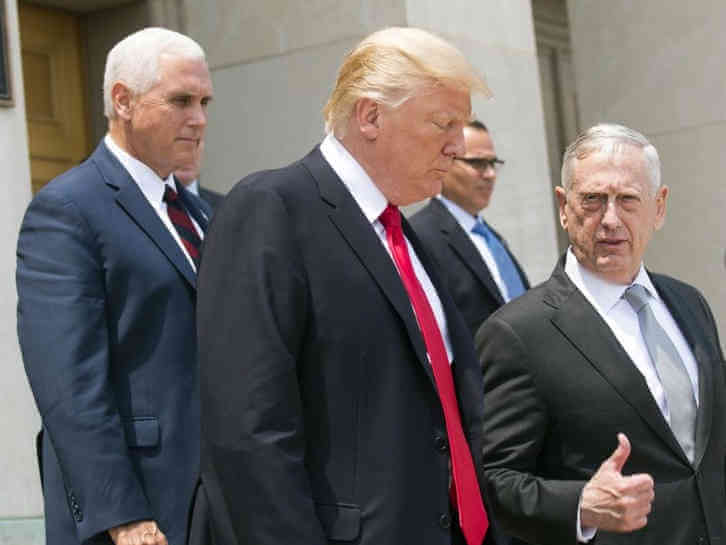Ruling in one of the lawsuits challenging the Trump administration’s new ban on transgender military service, a three-judge panel of the San Francisco-based Ninth Circuit Court of Appeals has delivered neither a complete win for the government nor one for the plaintiffs. As a result, Karnoski v. Trump will go forward before District Judge Marsha J. Pechman in Seattle. However, Pechman is now bound by different legal tests than she had applied in rulings the Trump administration had appealed. Since neither side will be fully satisfied by the June 14 ruling, it is possible that one or both will seek reconsideration by a larger panel of the Ninth Circuit sitting en banc.
In 2016, President Barack Obama’s defense secretary, Ashton Carter, ended the long-standing ban on transgender military service but delayed allowing trans people to enlist until July 2017. Donald Trump’s first defense secretary, James Mattis, delayed that effective date until January 1, 2018. Trump, in a series of July 2017 tweets and a follow-up August memo, announced that trans folks would be ineligible for service. Mattis, at the president’s direction, developed a policy to carry out the Trump edict, meant to go into effect in March 2018.
The plan Mattis recommended abandoned the concept of a total ban and, in complicated fashion, attempted to shift its focus from transgender status to the condition of gender dysphoria. The Mattis plan allows some trans people to serve under certain conditions, depending on whether and when they were diagnosed with gender dysphoria, whether and when they intended to transition or had transitioned, and whether they were willing to serve in their gender as identified at birth. People who had been diagnosed with gender dysphoria were barred from enlisting, and currently serving transgender personnel who had not been diagnosed and had not initiated the process of transitioning by the time the Mattis policy went into effect could continue serving only if they served in their birth gender. Those who were serving and had begun transitioning before the 2018 policy went into effect could continue serving in the gender to which they had transitioned. People who identify as transgender but have not been diagnosed with gender dysphoria and are content to serve in the gender identified at birth can enlist and serve, but must leave the service if they are subsequently diagnosed with gender dysphoria.
The bottom line, which was motivation for Trump’s initial tweet, is that once the new policy was in place, the military would not be funding sex-reassignment surgery and people could not transition in the military. (For a look at the military branches’ confusion or evasion about the new policy, see Matt Tracy’s “Trans Ban Rollout Marked By Secrecy, Chaos” in last week’s Gay City News at tinyu
Beginning in August 2017, challengers filed four lawsuits challenging the Mattis policy on constitutional grounds in Baltimore, Washington, DC, Seattle, and Riverside, California. Within months, each of the federal district judges had issued preliminary injunctions against the new policy going into effect. In issuing those injunctions, the judges had to find that the plaintiffs’ legal arguments had a fair chance of succeeding on the merits, and that the injunctions were necessary to prevent irreparable harm to the plaintiffs while not harming the public interest. Each of the four district judges refused to stay their injunctions, and the Fourth and DC Circuits upheld the district judges in Baltimore and Washington, respectively, in their denying stays. That led the government to abandon any attempt to appeal the denial of stays at the Ninth Circuit for the Seattle and Riverside cases.
As a result, on January 1 of last year, the Defense Department was required to accept enlistment applications from transgender people, and the 2016 Carter policy remained in effect for transgender people actively serving.
In February of last year, Mattis, based on the report of a task force he appointed, recommended an implementation policy to Trump and urged him to substitute that for the August 2017 White House memorandum. The administration has consistently resisted discovery requests on the identity of the Mattis task force members or the basis on which they came to the conclusions in their report.
Once the Mattis plan was substituted for the earlier Trump memorandum, the Justice Department moved to have the four injunctions lifted, arguing that the 2018 policy was sufficiently different from what the White House initially proposed to render the existing injunctions irrelevant. All four of the district judges rejected that argument and refused to dissolve their injunctions. Crucially, however, the government ultimately persuaded the Supreme Court earlier this year to stay the injunctions and allow the policy to go into effect early in April.
Although the 2018 policy has been in effect for over two months, there have not been reports about discharges of serving transgender personnel — and Tracy’s article from last week suggests a chaotic situation within the service branches on the policy.
Despite the lifting of the injunctions, the four lawsuits are proceeding, and the parties are litigating over the plaintiffs’ attempts at discovery. The government has fought discovery requests doggedly, arguing that the internal workings of its military policy-making should not be subject to disclosure, referring to but not formally invoking concepts of decisional privilege and executive privilege, which courts have recognized to a varying degree in prior cases challenging government policies.
In the Karnoski case in Seattle, Judge Pechman was highly skeptical about the government’s arguments, having questioned whether the policies were motivated by politics rather than professional military judgment, and she issued an order for the government to comply with a large portion of the discovery requests. The government appealed her discovery orders to the Ninth Circuit, together with Pechman’s refusal to rethink her preliminary injunction in light of the Mattis policy replacing the original Trump memorandum.
The Ninth Circuit panel agreed with the DC Circuit, which earlier this year concluded that the DC District Court was wrong to conclude the Mattis policy was just a slightly modified version of the original Trump policy. Both appellate courts held that the 2018 policy recommended by Mattis was no longer the total ban announced in 2017, so the district courts should evaluate the policy now in effect.
The court, however, rejected the government’s argument that shifting the grounds for exclusion from “transgender status” to “gender dysphoria” eliminated the equal protection issue, finding from the wording of the task force report and Mattis’ written summary that the policy now in effect continues to target transgender people, regardless of whether they have been diagnosed with gender dysphoria, in the conditions it places on their service. This was a “win” for the plaintiffs on an important contested point.
Pechman had concluded that gender identity is a “suspect classification,” so for purposes of evaluating the constitutionality of the policy under an equal protection challenge, it should be presumed unconstitutional with a heavy burden put on the government to prove a compelling need for it.
The Ninth Circuit panel decided there was not sufficient precedent to support that approach, but did agree with the position taken by the district judges in the other three cases that the policy should be subjected to “heightened scrutiny” — a less demanding level of judicial review than is warranted for a “suspect classification,” but similar to the approach courts take in sex discrimination cases. The key caveat the panel made here was consideration of the degree to which the policy merits the deference traditionally accorded military decision-making.
Pechman had concluded that Trump’s original policy did not merit judicial deference since there was no evidence it was the product of professional military judgment. Like the other district judges, she viewed the original policy as the product of a surprise tweet, for which the government failed to provide any information about its formulation.
The government has now described, at least in a general way, the Ninth Circuit panel found, how Mattis’ task force was put together, and its policy product — a 44-page report — was allegedly the result of serious study, many meetings, and interviews with military personnel. If one accepts the government’s description of that process, the court said, an argument can be made that the Mattis policy should be accorded judicial deference. Whether to do so, however, and how to align that analysis with the heightened scrutiny standard were questions to be addressed by the district court, the panel found.
Pechman must now determine whether the 2018 policy is sufficiently a product of military judgment to justify applying a deferential standard of review. Some degree of cooperation by the government in the discovery process will be necessary for her to carry out such an analysis. The Ninth Circuit panel, however, cautioned Pechman to give appropriate weight to decisional and executive privilege in formulating any discovery order.
The bottom line is that the Karnoski case goes back to Pechman for a fresh analysis of whether the plaintiffs are entitled to a preliminary injunction against the Mattis policy, using heightened scrutiny but also taking account of the administration’s privilege claims. This opinion also sends a message to the district court in Riverside, which is also under the Ninth Circuit’s jurisdiction. Discovery battles, meanwhile, continue in the Baltimore and Washington cases.
Given the Trump administration’s stiffening resistance to any demands for disclosure of internal Executive Branch decision-making, it is difficult to predict when there will be sufficient discovery to provide a basis for further rulings in the four pending court challenges. The litigation will not be finally resolved before Inauguration Day in January 2021 unless the Trump administration shows some cooperation in this discovery matter. Should a Democrat win next year, an executive order restoring the 2016 policy could put an end to the entire transgender military service drama and restore sanity to an issue clouded by politics and substantial misinformation, such as Trump’s recent grossly-exaggerated statements about the cost of health care for transgender personnel.


































